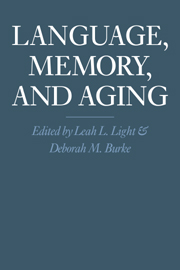Book contents
- Frontmatter
- Contents
- List of contributors
- Preface
- 1 Theories of information processing and theories of aging
- 2 Effects of aging on verbal abilities: Examination of the psychometric literature
- 3 Aging and individual differences in memory for written discourse
- 4 Geriatric psycholinguistics: Syntactic limitations of oral and written language
- 5 Aging and memory activation: The priming of semantic and episodic memories
- 6 Automatic and effortful semantic processes in old age: Experimental and naturalistic approaches
- 7 Integrating information from discourse: Do older adults show deficits?
- 8 Comprehension of pragmatic implications in young and older adults
- 9 Capacity theory and the processing of inferences
- 10 Age differences in memory for texts: Production deficiency or processing limitations?
- 11 Episodic memory and knowledge interactions across adulthood
- 12 The disorder of naming in Alzheimer's disease
- 13 Language and memory processing in senile dementia Alzheimer's type
- 14 Patterns of language and memory in old age
- Author index
- Subject index
1 - Theories of information processing and theories of aging
Published online by Cambridge University Press: 05 January 2012
- Frontmatter
- Contents
- List of contributors
- Preface
- 1 Theories of information processing and theories of aging
- 2 Effects of aging on verbal abilities: Examination of the psychometric literature
- 3 Aging and individual differences in memory for written discourse
- 4 Geriatric psycholinguistics: Syntactic limitations of oral and written language
- 5 Aging and memory activation: The priming of semantic and episodic memories
- 6 Automatic and effortful semantic processes in old age: Experimental and naturalistic approaches
- 7 Integrating information from discourse: Do older adults show deficits?
- 8 Comprehension of pragmatic implications in young and older adults
- 9 Capacity theory and the processing of inferences
- 10 Age differences in memory for texts: Production deficiency or processing limitations?
- 11 Episodic memory and knowledge interactions across adulthood
- 12 The disorder of naming in Alzheimer's disease
- 13 Language and memory processing in senile dementia Alzheimer's type
- 14 Patterns of language and memory in old age
- Author index
- Subject index
Summary
The goal of the present chapter is truly introductory. In it, I attempt to provide a theoretical context for the chapters that follow and to raise some general issues. The chapter first outlines a “modal model” of human information processing, particularly that related to memory and language. It then assesses weak and strong contributions that the information-processing approach could make to research on aging.
The modal model
Some 20 years ago, Murdock (1967) used the term “modal model” to describe the then dominant two-store conception of human memory. An important assumption of this model was that there existed two discrete functional units in the memory system, one for active storage and rehearsal of a limited amount of information (short-term memory), the other a more temporally extended, capacious repository of knowledge (long-term memory). This modal model has come under intensive fire, both for its limited perspective on what memory is, and for its rigid partitioning of the memory system. Nonetheless, the fundamental distinction of the model has persisted, in various forms.
In general, human information-processing theory provides two types of description: Structural descriptions pertain to the data stored in memory – both the functional components in which they reside, and the nature of the data themselves. Processing descriptions pertain to the use of those data – the states they may enter and the transitions between different data representations and stores. Any account of a behavioral phenomenon in information-processing terms must make assumptions about both structures and processes.
Information
- Type
- Chapter
- Information
- Language, Memory, and Aging , pp. 1 - 16Publisher: Cambridge University PressPrint publication year: 1988
Accessibility standard: Unknown
Why this information is here
This section outlines the accessibility features of this content - including support for screen readers, full keyboard navigation and high-contrast display options. This may not be relevant for you.Accessibility Information
- 3
- Cited by
